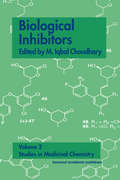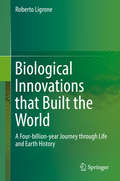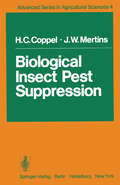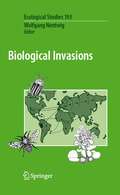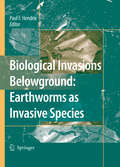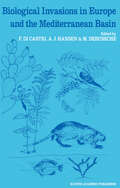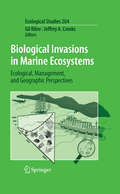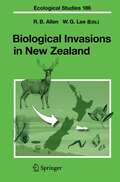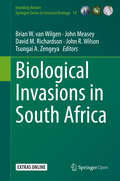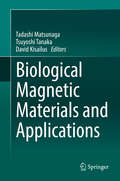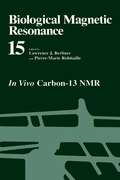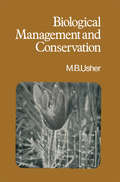- Table View
- List View
Biological Inhibitors
by M. Iqbal ChoudharyThis book, a part of the series Studies in Medicinal Chemistry, details the biological inhibitors that reflect drug discovery in treating human diseases, including cardiovascular, nervous, inflammatory, hormonal and metabolic processes. Compounds for fungal diseases and HIV/AIDS are also covered.
Biological Innovations that Built the World: A Four-billion-year Journey through Life and Earth History
by Roberto LigroneThe book is a detailed account of major biological events that contributed to create the present world and our species, with emphasis on cause-effect interrelationships and environmental impact. Its main goal is to guide the reader toward an understanding of the continuity of life across diversity, and of its large-scale interactions with the planet. Combining scientific soundness with a constant effort for clarity, the book begins with a cloud of dust in a corner of the Galaxy and, covering an immense lapse of time, terminates with an organism that ponders about the texture of the Universe. Comprehensive, updated references added to each chapter will help the reader wishing to expand any of the topics. A glossary explains less common technical terms.
Biological Insect Pest Suppression (Advanced Series in Agricultural Sciences #4)
by H. C. Coppel J. W. MertinsThe subject area embraced by the term "biological control" in its classical sense is very broad indeed. The term itself was apparently first used in 1919 by the late Harry S. Smith, and was then used specifically in reference to the suppression of insect populations by the actions of their indigenous or introduced natural enemies. The California school of biological control specialists who followed in Smith's footsteps have traditionally differentiated "natural" biological control (by indigenous natural enemies) and "applied" biological control (by man-introduced natural enemies). Subsequently, the philosophy broadened beyond the original narrow concern with population suppression of insects (and especially pest insects), to embrace directed activities against mites or other arthropod pests, various invertebrate and vertebrate pests, weeds, and organisms producing disease in humans or their domestic animals and plants. The techniques used in these activities also multiplied beyond the original concern with natural enemies. The subjects area discussed in this book is, at the same time, broader and more restricted than that covered in other books on "biological control. " On the one hand, the treatment here is restrictive in that, with rare exception, we have limited ourselves to dealing only with ideas and examples involving the suppression of insect pests through human activity or intervention in the environment.
Biological Interactions on Materials Surfaces: Understanding and Controlling Protein, Cell, and Tissue Responses
by Rena Bizios David A. PuleoSuccess or failure of biomaterials, whether tissue engineered constructs, joint and dental implants, vascular grafts, or heart valves, depends on molecular-level events that determine subsequent responses of cells and tissues. This book presents the latest developments and state-of-the-art knowledge regarding protein, cell, and tissue interactions with both conventional and nanophase materials. Insight into these biomaterial surface interactions will play a critical role in further developments in fields such as tissue engineering, regenerative medicine, and biocompatibility of implanted materials and devices. With chapters written by leaders in their respective fields, this compendium will be the authoritative source of information for scientists, engineers, and medical researchers seeking not only to understand but also to control tissue-biomaterial interactions.
Biological invaders in inland waters: Profiles, distribution, and threats (Invading Nature - Springer Series in Invasion Ecology #2)
by Francesca GherardiInvasive species have come to dominate 3% of the Earth’s ice-free surface, constituting one of the most serious ecological and economic threats of the new millennium, and freshwater systems are particularly vulnerable. This book examines the identity, distribution, and impact of freshwater non-indigenous species and the dynamics of their invasion. It focuses on old and new invaders and provides a starting point for further research.
Biological Invasions (Ecological Studies #193)
by Wolfgang NentwigThis new volume on Biological Invasions deals with both plants and animals, differing from previous books by extending from the level of individual species to an ecosystem and global level. Topics of highest societal relevance, such as the impact of genetically modified organisms, are interlinked with more conventional ecological aspects, including biodiversity. The combination of these approaches is new and makes compelling reading for researchers and environmentalists.
Biological Invasions and Its Management in China: Volume 1 (Invading Nature - Springer Series in Invasion Ecology #11)
by Fanghao Wan Mingxing Jiang Aibin ZhanThe book discusses invasive-species problems in agriculture, forests and aquatic ecosystems, highlighting the invasive mechanisms and management of the selected invasive species. Biological invasion has become a serious global ecological and economic problem that deserves particular attention from both government officials and scientists. This volume focuses on three key scientific areas: 1) population establishment and spreading mechanisms of the selected invasive species; 2) ecology adaptation, population growth, expansion and evolution of invasive species; and 3) impact of bio-invasion on the ecosystem structure and function at community and ecosystem levels. The presented research will result in techniques for better management of invasive species.
Biological Invasions and Its Management in China: Volume 2 (Invading Nature - Springer Series in Invasion Ecology #13)
by Fanghao Wan Mingxing Jiang Aibin ZhanThe book discusses invasive-species problems in agriculture, forests and aquatic ecosystems, highlighting the invasive mechanisms and management of the selected invasive species. Biological invasion has become a serious global ecological and economic problem that deserves particular attention from both government officials and scientists. This volume focuses on three key scientific areas: 1) population establishment and spreading mechanisms of the selected invasive species; 2) ecology adaptation, population growth, expansion and evolution of invasive species; and 3) impact of bio-invasion on the ecosystem structure and function at community and ecosystem levels. The presented research will result in techniques for better management of invasive species.
Biological Invasions Belowground: Earthworms as Invasive Species
by Paul F. HendrixThe papers in this book are based on efforts by an international group of soil ecologists to assess the biological and ecological mechanisms of earthworm invasions. They examine their geographic extent and impacts on terrestrial ecosystems, and possible means by which earthworm invasions might be mitigated. The book broadens the discussion on invasion biology and ecology to belowground systems.
Biological Invasions in Europe and the Mediterranean Basin (Monographiae Biologicae #65)
by F. Di Castri A. J. Hansen M. DebusscheIn view of the massive change in the area of distribution of many world biota across classical biogeographical realms, and of the drastic restructuring of the biotic components of numerous ecosystems, the Scientific Committee on Problems of the Environment (SCOPE) decided at its general Assembly in Ottawa, Canada, in 1982 to launch a project on the 'Ecology of Biological Invasions'. Several regional meetings were subsequently organized within the framework of SCOPE, in order to single out the peculiarities of the invasions that took place in each region, the behaviour of their invasive species and the invasibility of their ecosystems. Most noteworthy among such workshops were one in Australia in August 1984, one concerning North America and Hawaii in October 1984, and one dealing with southern Africa in November 1985. A leitmotiv of these workshops was that most of the invasive species to those regions were emanating from Europe and the Mediterranean Basin, inadvertently or intentionally introduced by man. It was therefore considered as a timely endeavour to organize the next regional meeting in relation to this region. The workshop on 'Biological Invasions in Europe and the Mediterranean Basin' was held in Montpellier, France, 21 to 23 May 1986, thanks to the financial support of SCOPE and of the A.W. Mellon Foundation, and the logistic facilities of the Centre National de la Recherche Scientifique (C.N .R.S.).
Biological Invasions in Marine Ecosystems: Ecological, Management, and Geographic Perspectives (Ecological Studies #204)
by Gil Rilov Jeffrey A. CrooksBiological invasions are considered to be one of the greatest threats to the integrity of most ecosystems on earth. This volume explores the current state of marine bioinvasions, which have been growing at an exponential rate over recent decades. Focusing on the ecological aspects of biological invasions, it elucidates the different stages of an invasion process, starting with uptake and transport, through inoculation, establishment and finally integration into new ecosystems. Basic ecological concepts - all in the context of bioinvasions - are covered, such as propagule pressure, species interactions, phenotypic plasticity, and the importance of biodiversity. The authors approach bioinvasions as hazards to the integrity of natural communities, but also as a tool for better understanding fundamental ecological processes. Important aspects of managing marine bioinvasions are also discussed, as are many informative case studies from around the world.
Biological Invasions in New Zealand (Ecological Studies #186)
by Robert B. Allen William G. LeeHuman colonization of New Zealand has dramatically altered the resident biota, introduced numerous alien organisms to these once remote islands, and exported local species to the world. This book reviews invasions, investigates what controls the success of invaders and studies the consequences for ecosystems both on land and offshore. The book tests current theories about the success of invaders and evaluates principles for effective management of biological invasions worldwide.
Biological Invasions in South Africa (Invading Nature - Springer Series in Invasion Ecology #14)
by Brian W. van Wilgen John Measey David M. Richardson John R. Wilson Tsungai A. ZengeyaThis open access volume presents a comprehensive account of all aspects of biological invasions in South Africa, where research has been conducted over more than three decades, and where bold initiatives have been implemented in attempts to control invasions and to reduce their ecological, economic and social effects. It covers a broad range of themes, including history, policy development and implementation, the status of invasions of animals and plants in terrestrial, marine and freshwater environments, the development of a robust ecological theory around biological invasions, the effectiveness of management interventions, and scenarios for the future. The South African situation stands out because of the remarkable diversity of the country, and the wide range of problems encountered in its varied ecosystems, which has resulted in a disproportionate investment into both research and management. The South African experience holds many lessons for other parts of the world, and this book should be of immense value to researchers, students, managers, and policy-makers who deal with biological invasions and ecosystem management and conservation in most other regions.
Biological Invasions in the South American Anthropocene: Global Causes and Local Impacts
by Fabián M. Jaksic Sergio A. CastroThis book provides a conceptually organized framework to understand the phenomenon of biological invasions at the Anthropocene global scale. Most advances toward that aim have been provided from North American and European researchers, with fewer contributions from Australia and South Africa. Here we fill the void from the Neotropics, focusing on the research experience in South American countries, with a strong emphasis on Argentina and Chile. The text is divided into two parts: The first half comprises self-contained chapters, providing a conceptual, bibliographic and empirical foundation in the field of invasion biology, from an Anthropocene perspective. The second half reviews the ecology, biogeography, and local impacts in South America of exotic species groups (European rabbit, Eurasian wild boar, Canadian beaver, North American mink, and Holarctic freshwater fishes), which are shown to be useful models for case studies of global relevance.
Biological Low-Voltage Scanning Electron Microscopy
by James Pawley Heide SchattenMajor improvements in instrumentation and specimen preparation have brought SEM to the fore as a biological imaging technique. Although this imaging technique has undergone tremendous developments, it is still poorly represented in the literature, limited to journal articles and chapters in books. This comprehensive volume is dedicated to the theory and practical applications of FESEM in biological samples. It provides a comprehensive explanation of instrumentation, applications, and protocols, and is intended to teach the reader how to operate such microscopes to obtain the best quality images.
Biological Magnetic Materials and Applications
by Tadashi Matsunaga Tsuyoshi Tanaka David KisailusThis book addresses the biologically controlled synthesis of magnetic materials, and its applications in bio-inspired design and synthesis. It highlights several key aspects of biologically produced magnetic materials – (i) organisms that biologically synthesize and utilize magnetic materials; (ii) formation mechanisms; (iii) how these biological formation routes yield various phases and morphologies; and (iv) the resultant magnetic and structural properties – and describes diverse bio-inspired approaches to utilizing magnetic materials in applications ranging from semiconductor to health industries.In addition, the book discusses the recent industrial use of magnetic materials to develop scalable technologies that encompass protein displays, drug-delivery, biophysical separations, and medical diagnostics, as well as outlining future next-generation applications. As such, it offers valuable insights for all scientists interested in using multidisciplinary fields to overcome current obstacles, and in gaining multifaceted expertise in magnetic materials bionanotechnology.
Biological Magnetic Resonance (Biological Magnetic Resonance #1)
by Lawrence BerlinerBiological magnetic resonance (NMR and EPR) is a rapidly expanding area of research with much activity in most universities and research institutions. International conferences are held biennially with an increasing number of participants. With the introduction of sophisticated and continuously im proving instrumentation, biological magnetic resonance is approaching the state of a common physical method in biochemical, biomedical, and bio logical research. The lack of monograpbs on the subject had been con spicuous for a long time. This gap started to close only recently. However, because of the rapid expansion and intensive research, many texts are dated by the time of their appearance. Therefore we have undertaken the editing of a series that is intended to provide the practicing chemist, biochemist, or biologist with the advances and progress in selected contemporary topics. In seeking to make the series as authoritative as possible, we have invited authors who have not only made significant contributions but who are also currently active in their fields. We hope that their expertise as well as their first hand experience as reflected in the chapters of this volume will be of benefit to the reader, inter alia, in planning his own experiments and in critically evaluating the current literature.
Biological Magnetic Resonance: Volume 5 (Biological Magnetic Resonance #5)
by Lawrence BerlinerJudging from the articles published in Biochemistry, magnetic resonance techniques (NMR and ESR) are now among the most popular methods in biochemical research. The series Biological Magnetic Resonance, the fifth volume of which we are proudly presenting, is intended to provide authori tative coverage of topics of current interest. Previous volumes have covered a number of aspects in a thorough and pedagogical fashion rarely found in other publications in this field. Continuing to fulfill the mission of the series, this volume presents a chapter by Baxter, Mackenzie, and Scott on the applications of carbon-13 NMR spectroscopy in investigations of methabolic pathways in vivo. Blom berg and Ruterjans give a comprehensive summary of the use of nitrogen-15 NMR in studies of systems of biological interest. Phosphorus-3I NMR investigations of enzyme systems are described by Rao. Tsai and Bruzik outline the principles of and summarize the state-of-the-art advances in the 18 use of oxygen isotopes e 70 and 0) in phosphorus-3I and oxygen-17 NMR studies of biophosphates. Lipid-protein interactions as reflected in ESR and NMR data are discussed by Devaux. We wish to thank the authors for their cooperation in maintaining the and continued high standards of the series.
Biological Magnetic Resonance: Volume 6 (Biological Magnetic Resonance #6)
by Lawrence BerlinerWe have now reached our sixth volume in a series which has somewhat unintentionally become an annual event. While we still intend to produce a volume only if a suitable number of excellent chapters in the forefront of biological magnetic resonance are available, our philosophy is to present a pedagogical yet critical description and review of selected topics in mag netic resonance of current interest to the community of biomedical scien tists. This volume fulfills our goals well. As always, we open the volume with a chapter which directly addresses an in vivo biological problem: Phil Bolton's presentation of new techniques in measuring 31 P NMR in cells. Lenkinski's chapter on the theory and applications of lanthanides in protein studies covers the details, highlights, and pitfalls of analysis of these com plexes in biochemical NMR. Reed and Markham summarize the interpreta tion of EPR spectra of manganese in terms of structure and function of proteins and enzymes. Dalton and colleagues describe the applications to biological problems of the relatively new capability of time domain ESR. Finally, we are pleased to offer a departure from mainstream magnetic resonance with the comprehensive and stimulating chapter by Gus Maki on the theory, instrumentation, and applications of optically detected magnetic resonance.
Biological Magnetic Resonance: Volume 2 (Biological Magnetic Resonance #2)
by Lawrence J. BerlinerWe are pleased to present this second volume of a series that has already received much interest. The application of magnetic resonance methods to the study of actual biological systems as contrasted to cell-free samples, although not entirely novel, as demonstrated by Civan and Shporer in Volume I, has taken on new dimensions with the use of phosphorus-31 and carbon-13 NMR in studying cells, tissues, and organelles. The applications of 31 P NMR to such systems is reviewed in this volume, while carbon-13 will be covered in a later one. The use of nitroxide spin labels has grown to the point where it now may be considered a common biological technique. The synthesis and applications of a new class of nitroxides is described in this volume. ESR spectroscopy of paramagnetic ions is a powerful approach to studying molecular and structural details, as the chapter by Boas, Pilbrow, and Smith on the ESR of copper in Volume 1 has shown. In this volume the ESR of molybdenum and iron is treated in a comparable fashion. In the first volume some aspects of 1 H NMR spectroscopy of certain classes of In this volume the high-resolu biological macromolecules were discussed.· tion multinuclear NMR spectra of peptides, including the physiologically significant peptide hormones, are reviewed.
Biological Magnetic Resonance (Biological Magnetic Resonance #4)
by Lawrence J. Berliner Jacques ReubenWe take great pleasure in presenting Vol. IV of Biological Magnetic Resonance, a series that continues to give us pride. In this volume, we are pleased to have our first chapter on the applications of ESR to problems in medicine, written by Butterfield. Armitage and Otvos describe their extensive Cd-l13 NMR study in a chapter that should delight the spectroscopists as well as the biochemists, since the systems investigated have not yet been modeled. Kaptein presents an eloquent exposition of the principles and applications to biological systems of the photo-CIDNP technique, to which he has made pioneering contributions. Perkins tells everything one always wanted to know about the applications of ring current calculations in structural studies of biological macromolecules. Our philosophy has been, and continues to be, to present topics of current interest by authors who are active in their field, while maintaining the inter national flavor of the series. Ideally, the coverage of each topic should approach that found both in a textbook and in a reference book, rather than being a mere literature review. We are grateful to the authors for their cooperation in this respect. We continue to solicit the comments and suggestions of our readers and our colleagues, and thank those who have already responded, including the reviewers in the periodicals. Lawrence J. Berliner Jacques Reuben ix Contents Chapter 1 Spin Labeling in Disease D. Allan Butterfield 1. Introduction ...................................... . 2. Membrane Structure . . . . . . . . . . . . . . . . . . . . . . . . . . 2 . . . . . . . 2.1. General Principles. . . . . . . . . . . . . . . . . . . . . . . . . . . . . . 2 2.2. The Erythrocyte Membrane. . . . . . . . . . . . . . . . . . . 4 . . . . .
Biological Magnetic Resonance: In Vivo Carbon-13 NMR (Biological Magnetic Resonance #15)
by Lawrence J. Berliner Pierre-Marie RobitailleThis volume constitutes a compilation of the latest experiments and theories on a rapidly evolving and maturing field in MRI/MRS, which is the use of the stable isotope 13-C. The 13-C is used to probe the chemistry, mechanism, and function in living systems. All the chapters are written by experts in the field who discuss topics such as `Tracer Theory and the Suitability of 13-C NMR', `Applications of 13-C to Studies of Human Brain Metabolism', etc.
Biological Magnetic Resonance (Biological Magnetic Resonance #9)
by Lawrence Berliner Jacques ReubenWe are pleased to present Volume 9 of our highly successful series, which now celebrates 12 years of providing the magnetic resonance community with topical, authoritative chapters on new aspects of biological magnetic resonance. As always, we try to present a diversity of topic coverage in each volume, ranging from applications of in vivo magnetic resonance to more fundamental aspects of electron spin resonance and nuclear magnetic resonance. Philip Yeagle presents an eagerly awaited chapter on 31p NMR studies of membranes and membrane protein interactions. Alan Marshall has con tributed two chapters to the volume: one, with Jiejun Wu, describes magnetic resonance studies of 5S-RNA as probes of its structure and conformation; the secon
Biological Magnetic Resonance Volume 3: (pdf) (Biological Magnetic Resonance #3)
by Lawrence J. Berliner Jacques ReubenBiological Management and Conservation: Ecological Theory, Application and Planning
by Michael B. UsherWhilst I have been writing this book two developments have been occur ring which have influenced ecological thinking, and which undoubtedly will have a great impact on ecologists in the future. One of these developments concerns the relation between the ecologist and the public. On the public's side there has been an increasing aware ness of ecological processes, and more emphasis on subjects such as the environment and pollution in newspapers and magazines. Maybe it was European Conservation Year 1970 (ECY 1970) that succeeded in stimu lating this interest. On the ecologist's side there has been a search for the relevance of his research in the world of today. The concern for relevance has been clearly reflected in the 'Comments' that have been written for the first few parts of the British Ecological Society's members' bulletin. The word 'conservation' has been widely used in the context of this relation between the public and the ecologist; indeed it might well be said that the word has been over-used, being applied to any form of protectionist operation. The second of the developments concerns the quantification of eco logical processes. Statistical analysis of experimental data has been applied for several decades, but the recent general availability of com puters has meant that mathematical analysis and computer modelling are tools that the ecologist can now use.
